Intel Celeron D (Prescott-256) processors
Introduction: June 2004
Overview
The Celeron brand refered to a range of Intel's x86 CPUs for budget/value personal computers. Considered Intel's "economic" processor, the Celeron branded processors had complemented Intel's higher-performance (and more expensive) brands. Intel had given the brand the motto, "delivering great quality at an exceptional value." Celeron processors was able to run all IA-32 computer programs, but their performance was somewhat lower when compared to similar, but higher priced, Intel CPU brands. For example, the Celeron brand often had less cache memory, or had advanced features purposely disabled. These missing features had a variable impact on performance. In some cases, the effect was significant and in other cases the differences were relatively minor. Many of the Celeron designs had achieved a very high "bang to the buck," while at other times, the performance difference had been noticeable. For example, some intense application software, such as cutting edge PC games, programs for video compression, video editing, or solid modeling (CAD, engineering analysis, computer graphics and animation, rapid prototyping, medical testing, product visualization, and visualization of scientific research), etc. may not performed as well on the Celeron family. This had been the primary justification for the higher cost of other Intel CPU brands vs. the Celeron.
The Prescott-256 core
Prescott-256 Celeron D processors, initially launched June 25, 2004, featured double the L1 cache (16KB) and L2 cache (256KB) as compared to the previous Willamette and Northwood desktop Celerons, by virtue of being based on the Prescott Pentium 4 core. It also featured a 533MT/s bus and SSE3, and a 3xx model number (compared to 5xx for Pentium 4s and 7xx for Pentium Ms). The Prescott-256 Celeron D was manufactured for socket 478 as well LGA 775, and they were released carrying model numbers of 355 (3.33GHz), 350 (3.2GHz), 345 (3.06GHz), 340 (2.93GHz), 335 (2.80GHz), 330 (2.66GHz), 325 (2.53GHz), 320 (2.40GHz), 315 (2.26GHz), and 310 (2.13GHz). They also had hardware-level support of Intel's Intel 64 technology by virtue of it also being built into the Prescott core, although the feature was disabled in all 3x0/3x5 models (with the exception of the Celeron D model 355). It had been activated in all 3x1 and 3x6 models. The Intel Celeron D processor worked with the Intel 845 and 865 chipset families. It should be noted that the "D" suffix had no official designation. It was used simply to distinguish this line of Celeron from the previous, lower performing Northwood and Willamette series, and also from the mobile series, the Celeron M. It should also be stated that unlike the Pentium D, the Celeron D was not a dual core processor.
The Celeron D was a major performance improvement over previous Netburst Celerons. A test using a variety of applications, run by Derek Wilson at Anandtech.com, showed that the new Celeron D architecture alone offered up performance improvements on average of >10% over a Northwood Celeron when both CPUs were run at the same bus and clock speed. The addition of SSE3 instructions and the higher FSB only added to this already impressive gain.
Despite its many improvements, the Prescott core of the Celeron D had at least one major drawback: heat. Unlike the fairly cool running Northwood Celeron, the Prescott-256 had a class-rated TDP of 73 watts, which prompted Intel to include a more intricate copper core/aluminum finned cooler to help handle the additional heat.
In mid-2005, Intel refreshed the Celeron D with Intel 64 and XD Bit (eXecute Disable) enabled. Model numbers increased by 1 over the previous generation (e.g. 330 became 331). This only applied to LGA 775 Celeron Ds. There was no Socket 478 CPU with 64-bit or XD Bit capabilities.
In Intel's "Family/Model/Stepping" scheme, Prescott Celeron Ds and Pentium 4s were family 15, model 3 (up to stepping E0) or 4 (stepping E0 onwards), and their Intel product code was 80546 or 80547, depending on socket type.
Source: Wikipedia, the free encyclopedia.



